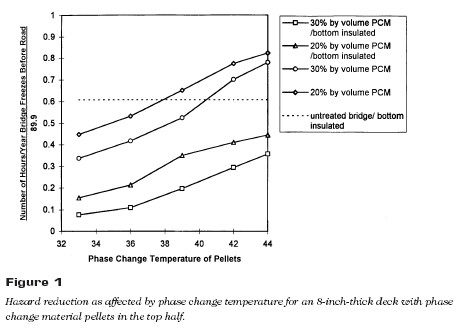This project evaluated a class of polymeric materials (linear crystalline alkyl hydrocarbons) that stored and released heat energy as a result of phase change in freezing temperatures for use in concrete to prevent overnight freezing of bridge decks. The phase change materials were encapsulated in high density polyethylene pellets and either mixed with or installed around concrete to provide heat energy. Modeling verification of the thermal response of bridges and roads under varying climatic conditions and with various phase change materials and application methods was performed. This was followed by laboratory tests and limited field evaluation to establish material performance and effectiveness in the highway freezethaw environment.
The test results show that the addition of phase change materials to the concrete prevented freezing on the surface (Figure 1). However, the addition of the materials also decreased the conductivity of concrete slabs, which slowed its warming and also adversely affected the performance of phase change materials. Placing the material at the bottom of the concrete slab delayed the cooling of the slab top surface. It also slowed its warming, which was not desirable. Darkening the top surface had a beneficial effect on the slab surface temperature. The final report is available from the National Technical Information Service (NTIS # PB97-143820).

The final report for this IDEA project can be found at:
https://onlinepubs.trb.org/onlinepubs/archive/studies/idea/finalreports/highway/NCHRP022_Final_Report.pdf